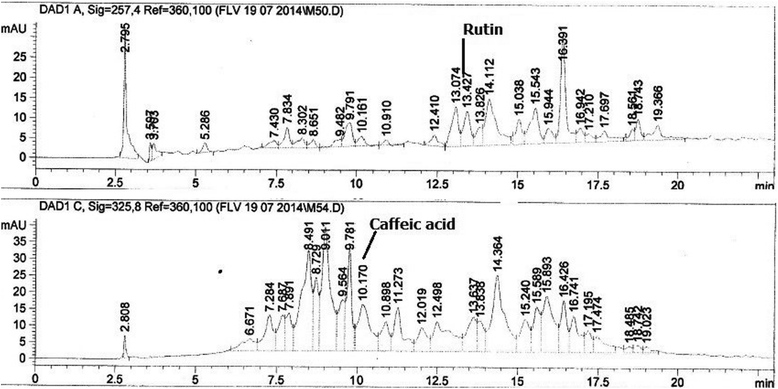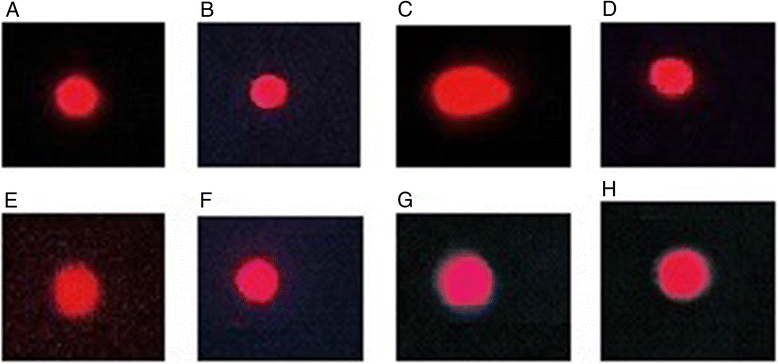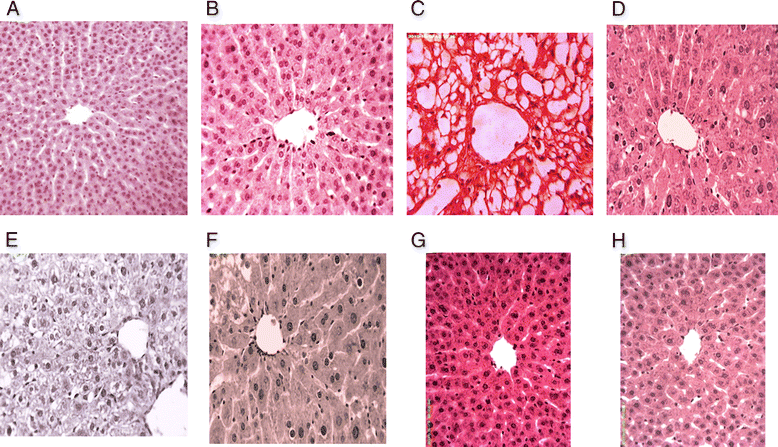Protective effects of Fraxinus xanthoxyloides (Wall.) leaves against CCl4 induced hepatic toxicity in rat
- PMID: 27776508
- PMCID: PMC5078913
- DOI: 10.1186/s12906-016-1398-0
Protective effects of Fraxinus xanthoxyloides (Wall.) leaves against CCl4 induced hepatic toxicity in rat
Abstract
Background: Leaves and root bark of Fraxinus xanthoxyloides Wall. (Oleaceae) are used locally for the treatment of jaundice, malaria and pneumonia. Decoction of stem, twigs and bark is used in pain, internal injuries, rheumatism and in bone fracture. In this investigation we have evaluated the methanol extract of leaves for its hepatoprotective potential against CCl4 induced hepatic injuries in rat.
Methods: Powder of F. xanthoxyloides leaves was extracted with methanol (FXM) and subjected for the determination of polyphenolics through HPLC-DAD analysis. Sprague-Dawley (Rattus novergicus) male rats were divided into eight groups (six rats in each). Group I: non-treated control; Group II: vehicle treated (DMSO plus olive oil) while Group III- VI treated with 1 ml/kg body weight (bw) of CCl4 (30 % in olive oil) for 30 days (15 dosages) to induce the hepatic injuries. Group IV: treated with silymarin (100 mg/kg bw); Group V and VI with FXM (200, 400 mg/kg bw) on alternate days with CCl4 treatment. Group VII and VIII was administered with FXM (200, 400 mg/kg bw) alone (15 dosages). After 30 days the serum was evaluated for liver function enzymes and biochemical markers, liver samples for antioxidant enzymes, biochemical markers, comet assay and for histopathology.
Results: HPLC-DAD analysis of FXM revealed the existence of rutin and caffeic acid. In CCl4 treated rats the level of alanine transaminase (ALT), aspartate transaminase (AST), total bilirubin was significantly increased while the albumin concentration in serum was decreased as compared to control group. The level of hepatic antioxidant enzymes, catalase (CAT), peroxidase (POD), superoxide dismutase (SOD), glutathione-S-transferase (GST) and glutathione reductase (GSR) was significantly decreased against the control group. Further, significant decrease in GSH while increase in lipid peroxides (TBARS), H2O2, DNA damages and comet length was induced with CCl4 in hepatic tissues of rat. In contrast, co-administration of FXM and silymarin restored the biochemical and histopathological status of the liver.
Conclusion: Results of present investigation revealed that F. xanthoxyloides leaves possibly protect the liver against CCl4 induced injuries like silymarin by its antioxidant constituents.
Keywords: Antioxidant; CCl4; Fraxinus xanthoxyloides; Lipid peroxidation; Liver; Phenolics.
Figures



Similar articles
-
Euphorbia dracunculoides L. abrogates carbon tetrachloride induced liver and DNA damage in rats.BMC Complement Altern Med. 2017 Apr 20;17(1):223. doi: 10.1186/s12906-017-1744-x. BMC Complement Altern Med. 2017. PMID: 28427398 Free PMC article.
-
Hepatoprotective effects of methanol extract of Carissa opaca leaves on CCl4-induced damage in rat.BMC Complement Altern Med. 2011 Jun 24;11:48. doi: 10.1186/1472-6882-11-48. BMC Complement Altern Med. 2011. PMID: 21699742 Free PMC article.
-
Antioxidant and Pulmonary Protective Potential of Fraxinus xanthoxyloides Bark Extract against CCl4 -Induced Toxicity in Rats.Chem Biodivers. 2023 Mar;20(3):e202200755. doi: 10.1002/cbdv.202200755. Epub 2023 Feb 24. Chem Biodivers. 2023. PMID: 36722706
-
Ameliorating role of methanolic leaves extract of Fraxinus xanthoxyloides against CCl4-challanged nephrotoxicity in rats.Pak J Pharm Sci. 2018 Jul;31(4(Supplementary)):1475-1484. Pak J Pharm Sci. 2018. PMID: 30058538
-
Protective effects of Monotheca buxifolia fruit on renal toxicity induced by CCl4 in rats.BMC Complement Altern Med. 2016 Aug 17;16(1):289. doi: 10.1186/s12906-016-1256-0. BMC Complement Altern Med. 2016. PMID: 27530158 Free PMC article.
Cited by
-
Targeting Mitochondrial Metabolism in Prostate Cancer with Triterpenoids.Int J Mol Sci. 2021 Feb 28;22(5):2466. doi: 10.3390/ijms22052466. Int J Mol Sci. 2021. PMID: 33671107 Free PMC article. Review.
-
Euphorbia dracunculoides L. abrogates carbon tetrachloride induced liver and DNA damage in rats.BMC Complement Altern Med. 2017 Apr 20;17(1):223. doi: 10.1186/s12906-017-1744-x. BMC Complement Altern Med. 2017. PMID: 28427398 Free PMC article.
-
Fraxinus: A Plant with Versatile Pharmacological and Biological Activities.Evid Based Complement Alternat Med. 2017;2017:4269868. doi: 10.1155/2017/4269868. Epub 2017 Nov 27. Evid Based Complement Alternat Med. 2017. PMID: 29279716 Free PMC article. Review.
-
Anti-Obesity and Gut Microbiota Modulation Effect of Secoiridoid-Enriched Extract from Fraxinus mandshurica Seeds on High-Fat Diet-Fed Mice.Molecules. 2020 Sep 2;25(17):4001. doi: 10.3390/molecules25174001. Molecules. 2020. PMID: 32887336 Free PMC article.
-
Evaluation of Phytochemistry and Pharmacological Properties of Alnus nitida.Molecules. 2022 Jul 18;27(14):4582. doi: 10.3390/molecules27144582. Molecules. 2022. PMID: 35889458 Free PMC article.
References
MeSH terms
Substances
LinkOut - more resources
Full Text Sources
Other Literature Sources
Medical
Research Materials
Miscellaneous

